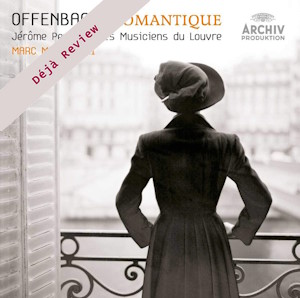
Déjà Review: this review was first published in January 2007 and the recording is still available.
Jacques Offenbach (1819-1880)
Romantique
Orphée aux enfers (Orpheus in the Underworld) – Overture (1874)
Concerto militaire for cello and orchestra (1847)
Les Fées du Rhin (The Rhine Nixies) (1864): Overture; Ballet; Grande Valse
Ballet des Flocons de neige (Ballet of the Snowflakes) from Le Voyage dans la Lune (The Voyage to the Moon) (1875)
Jérome Pernoo (cello)
Les Musiciens du Louvre, Grenoble/Marc Minkowski
rec. 2006, La Maison de la Culture, Grenoble, France
Archiv Produktion 4776403 [79]
This delightful collection of Offenbach works is interesting because it includes some lesser-known material by this composer. The alert collector may have already come across the reconstructed Les Fées du Rhin, heard for the first time at the 2002 Montpellier Festival. It recording on Accord was given a full review on the Musicweb-International site. The sprightly Concerto Militaire is little known, if at all, and worthy of an appearance in the concert hall while the Ballet of the Snowflakes, although not known by name, will be somewhat familiar.
The opening overture, Orpheus in the Underworld is a different and earlier arrangement from the one regularly heard. It lacks the powerful opening and instead starts with a strongly rhythmic haunting number ‘I was a King’. Here, the overture is played at a graceful pace though some listeners may prefer the energy that a faster reading from certain ‘gusto’ conductors ensures. For me, only the opening could be brisker for the middle larghetto sections sound ideal.
The Concerto Militaire has been shrouded in mystery. Only one complete performance was known to have taken place – in Cologne, 1848 – although Offenbach himself played its opening movement back in 1847 (Paris). Offenbach’s grandson unearthed the first movement and a new edition had been prepared by the cellist, Clement, using piano sketches to re-orchestrate the missing second and third movements. Jean-Christophe Keck’s CD notes tell us that his reconstruction was uneven and incomplete. Since then, the manuscripts of the two missing movements have recently been discovered in Cologne city’s archives and in Washington’s Library of Congress, USA. They are used here for the first time.
The concerto is a cheery piece with a display of scintillating cello virtuosity that banishes a doleful lethargic prominence that cellos often exhibit in their concertos. In parts, I find this piece could be by Suppé (Poet and Peasant perhaps) – its bouncy tempo is so bright. As a cello player himself, Offenbach indulges in more than the usual virtuoso element and as a result forfeits a strong thematic flow.
In this recording, the thirty-four year old competition-winning cellist of the Paris Conservatoire, Jérome Pernoo, has much technical difficulty to contend with, yet is perfectly wedded to Offenbach’s demands. His sensitive reading throughout, for me, magnifies my interest in the piece. The acoustic for the soloist is dry (close miking) and could have benefited from the added bloom that deeper reverberation might have given.
The Les Fées du Rhin overture is essentially the complete barcarolle from Tales of Hoffmann. This haunting tune was originally written as the Song of the Elves for this operetta, written fifteen years earlier. The work was forgotten until this barcarolle brought lasting fame in Tales of Hoffmann. Compared against the one existing full recording of Les Fées (Accord 472 920-2), this reading chops 20 seconds from its 5:20 duration, thus benefiting from a slightly faster pace. As a studio recording it is free from the slight background disturbances noticed in the quieter passages of the live Montpellier version, yet disappointingly recesses some of the delicate atmospheric background effects provided by the violins behind the main theme. In the Grand Valse, an accentuated beat from the percussion is likely to be more Minkowski’s interpretation than a double forte score marking and makes the passage more Russian than French. Here I can only visualize elephants trying to dance in a fairyland landscape.
Le Voyage dans la Lune is generally unknown and so the appearance here of its Ballet des Flocons de Neige is most welcome. The notes give little help with background detail (as does Gammon’s biography apart from indicating that the operetta played in London the same year along with Sullivan’s The Zoo, 1873). For me, the music has character and the Polka will be recognized as a familiar theme, transferred to Offenbach’s ballet Gaité Parisienne (Rosenthal, 1904).
Modestly, Marc Minkowski leaves all the biographical space in the booklet to Pernoo and so I had to seek background information elsewhere. It seems that this recording might be the first occasion Minkowski has met a light-weight composer and I wonder if his approach might be too heavy. Originally a bassoonist, he was awarded the Orphée d’Or as “Best Young Conductor” in 1990 having won First Prize at the first International Early Music Competition (Bruges 1984). That same year he founded Les Musiciens du Louvre, a Paris-based period-instrument ensemble, to perform Baroque and Classical repertoire. I am not sure how these period instruments relate this disc, which on the cover boasts “instruments originaux”. In the 1990s, he revived Gluck, then Handel (Welsh National Opera, 1994) and later involved himself in Mozart. With Les Musiciens du Louvre, Minkowski signed an exclusive contract with Archiv Produktion in 1994, hence this issue.
In more than a couple of places, I notice that the conductor’s breath intake is irritatingly audible but generally the recording is good. The notes are provided in English, French and German.
Raymond J Walker
Buying this recording via a link below generates revenue for MWI, which helps the site remain free


















